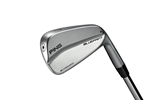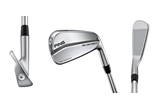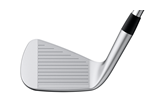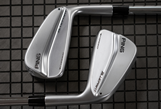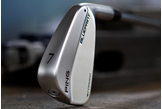Ping reveal new forged Blueprint iron
Published: Last updated:
Ping have made some brilliant irons over the years, but amazingly only three have ever been forged (the original Ping 69 and the Anser in 2010 and 2012).
Ping argues that superior metallurgy and heat treating knowledge, along with elastomer-filled cavities, allow their cast irons to feel and sound every bit as good as any forged iron available.
In fact, a few years ago they created identical forged and cast irons and their Tour players couldn’t tell the difference between the pair.
But in October 2018, Louis Oosthuizen rocked up at the Dunhill Links Championship in Scotland with a new forged Ping iron in his bag.
The company wasn’t keen to release details on the Blueprint iron at the time, but since then Bubba Watson, Tony Finau and Cameron Champ have all been spotted with them in the bag, raising speculation the brand were about to launch a new forged iron.
It’s taken until May 2019, but Ping are now ready to pull the covers from the new model, and make them available to the public.

TESTED: Which Ping iron suits me?
Who are the Ping Blueprint irons for?
Ping say Blueprint irons are for golfers seeking more precision from their ironplay, which basically means those wanting better shot shaping ability and trajectory control.
Each Blueprint head is a single piece of 8620 carbon steel which goes through a four-stage forging process.
There’s smaller, cleaner profiles than the iBlade (which stays in the Ping line-up), along with shorter blade lengths and narrower soles.
The muscleback design isn’t a hollow body, though there are tungsten weights in the toe and hosel to improve stability, and every face and groove is CNC milled to ensure consistency.
All in then it’s no surprise the Blueprint is a players model aimed at seriously skilled golfers looking to enhance their game with a super workable and versatile iron.
TESTED: Best 2019 Player irons

90% of tour events are won with forged irons, so we asked Ping engineers, why are the Blueprint forged? And why now is the right time to forge a Ping iron?
Ping irons have traditionally been cast, how have the Blueprint come to be forged?
We decided to forge Blueprint irons as the head shape and muscleback geometry goes hand in hand with this type of manufacturing method. The overall shape and sizing work well with traditional forging capabilities, it also allows us to hold very tight dimensional tolerances.
Is the Blueprint iron one-piece forged? Which material is it made out of? Why are these important for performance?
Yes, Blueprint are one-piece forged. The iron starts life as an 8620-carbon steel billet, it goes through a four-step forging process to achieve a very precise finished iron. 8620-carbon steel is an ideal forging material as it’s stronger than most forging alloys. It allows us to make the iron more durable and longer lasting than other forged irons.
Why is now the right time to produce a new Ping forged iron?
The emphasis of Blueprint is understanding the characteristics of a smaller, more workable iron. Our focus was working with elite tour players to recognize aspects of the iron design such as heel-toe length, sole width, and offset that allow these golfers to maximize their shot making abilities. The decision to forge the iron was secondary, to making an iron that’s more forgiving and versatile.

TESTED: Best Game Improver irons 2019
Does the Blueprint represent a new Ping iron era, or is this just a one-off forging?
The focus for Blueprint was to achieve club characteristics that aid a player with improving their shot making ability. To that end we see Blueprint serving a new space in our iron market. Looking into the future, there are new technological horizons with both the casting and forging processes. There are opportunities to use higher strength materials that haven’t been available in the forged arena before, but we’re also looking at new casting techniques that allow for more complex and mass efficient geometries to improve forgiveness. It really depends on the design intent of the iron as to which method may provide a better solution.
Does a Ping forged iron ‘feel and/or sound’ different compared to a cast model?
If you manufacture the exact same iron design through forging and casting it would be nearly impossible to tell the difference. We conducted this study several years ago with our tour players to support this result. What produces such a pleasing feel/sound with Blueprint’s is a combination of geometry (that’s having the muscleback thickness right through the hitting zone), and the material selection. Nowadays we’ve advanced the impact experience with activated elastomer, such that many golfers perceive the iBlade and i210 irons to feel as good or better than forged irons on the market.
There seems to be lots of forged club golfer irons on the market, are more golfers switching to using forged irons?
There’s certainly more forged iron options that appeal to club players compared to past years. This is mainly due to having a wider selection of forged irons that serve different purposes. For instance, we now have forged, distance irons, along with forged, muscleback and cavity style irons. Club players of all handicaps have options that were not available as little as five years ago.
There’s only ever been a few forged Ping irons, how do you decide when a model needs to be forged?
Our choice to forge a product is less about starting with the decision to make a forged model, but to see if the design intent aligns with using the forged manufacturing process. With the Anser irons (in 2010 and 2012) the forging process helped with precision in welding the tungsten sole weight. This was also true for Anser and Glide Forged wedges. The Blueprint iron is forged because the overall size and muscleback geometry is a great candidate for one-piece forging.

The Blueprint has a toe screw like the G410 irons, how does this affect performance compared to other muscleback irons?
The toe screw supports performance in two key functions. The first is improving forgiveness. We utilize a high-density weight on the toe and in the hosel which is ideal for increasing moment of inertia. The second is, the toe screw supports our ability to build a wide array of custom sets. Between the hosel and toe screw weights we can achieve the desired swingweight for many grip, shaft, and length options.
TESTED: Best Hollow Body irons 2019
Where does the Blueprint sit in the Ping iron line up, who’s it aimed at?
The Blueprint is smaller and more compact than the iBlade, it’s part of our suite of irons that principally aim at precision and control. This iron is not a replacement for iBlade, instead it serves as an alternative option that can amplify shot making and versatility for golfers desiring to work the ball. In general, Blueprint irons launch and spin similar to iBlades, delivering similar distance, but can deliver greater control and workability.
How much input did tour players have into the Blueprint?
We worked heavily with a select group of Ping tour players to design the Blueprint. We started by discussing the aspects of iron designs that helps them excel in competition. We then prototyped a small set of irons to gain feedback and confirm the size, shaping, and performance aligned with our intent. From there, we created the Blueprint irons we introduced on tour and are now selling to the end consumer.

What Ping say about the Blueprint irons
Focusing on the needs of highly skilled golfers who rely on pinpoint accuracy, Ping introduced the Blueprint, a forged-blade iron, sized and shaped to ensure the workability and confidence required to play with score-lowering precision.
“As the name suggests, we’ve applied a Blueprint approach to the new irons,” said John K. Solheim, Ping President. “Every detail is extremely precise and carefully calculated. The resulting design is spectacular in every way for the elite player — performance, feel and looks. It’s a true shot-maker’s iron crafted with precision, and for precision.”
With that in mind,” Solheim continued, “we know the Blueprint iron isn’t for everyone. We encourage golfers interested in the Blueprint to get fit and compare it to other Ping designs to find the best solution for their game. To paraphrase the warning sign next to the first tee at Bethpage Black during the PGA Championship, ‘The Blueprint is an extremely difficult iron to play, which we recommend only for highly skilled golfers.’
Workability, versatility
Fully forged from 8620 carbon steel, the Blueprint’s small blade design appeals to the player who puts a premium on workability and trajectory control. Shorter blade lengths, less offset and narrow sole widths optimized to perform in all conditions give elite players an iron to attack any pin with confidence. A machined tungsten toe screw increases the MOI for additional forgiveness and combines with an internal heel weight to provide precise swing-weight tuning.
“I put them in play immediately once they arrived,” said Ping pro Tony Finau, the 15th –ranked player in the world. “They’re workable, incredibly versatile and feel great. There isn’t a single shot I can’t hit with them, which gives me a lot of confidence in pressure situations. The look at address is also perfect; the size and shape really fit my eye.”
Tour inspired, Tour validated
Based on requests from several Ping professionals for a blade-style iron sized and shaped to deliver more control and workability, Ping’s engineering team took a scientific, methodical approach to the development and design of the Blueprint iron. Through on-course observation sessions and conversations with the players about the shots they rely on to excel in competition, the engineers began the prototyping process to apply their learnings and gather additional feedback. After extensive in-house research with varying head sizes, the findings revealed the theory of “aim small, miss small” was validated by many of the highly skilled players in the test, who produced tighter stat areas when hitting the more compact head. That design was prototyped in limited quantities and released on tour nine months before the official introduction.
“When we launched it on tour, a few players put it in play immediately and it wasn’t long before we had our first win,” continued Solheim. “Based on a lot of their input, we were able to deliver exactly what they were looking for while expanding our iron offerings into a new category. We’re very pleased with the development process we went through and are looking forward to applying our learnings to future Ping products.”
Four-step forging process
A four-step, multi-stage process for the one-piece forging provides very tight dimensional tolerance control within the compact design. The high-strength, 8620 carbon steel increases the iron’s durability, ensuring long-lasting performance and quality. More than 50 steps in the manufacturing process, including machining the face and grooves, are 100% inspected.
Pleasing sound and feel
The choice of 8620 carbon steel combined with a head design that concentrates mass through the impact zone delivers a pleasing sound and feel.
“The feel is amazing,” reports Ping pro Louis Oosthuizen, who was the first player to put the new irons in his bag last fall and the first to win with them at the South African Open in December. “I love the feedback I get and how smoothly they go through the turf from any lie. They’re like no other iron I’ve ever hit. The Blueprint’s workability gives me the control to hit all the shots with the precision I need to win tournaments.”
Blueprint Iron Specifications
Manufacturing process: One-piece, four-step, multi-stage forging
Materials/finish: 8620 carbon steel, tungsten toe/heel weights, hydropearl 2.0 finish
Available: 2-9, PW, +- 2 degrees lie angle
Stock grip: Golf Pride MCC Align Black/White (Std, Mid)
Optional grips: Golf Pride Tour Velvet 360 in six sizes (Blue -1/16″, Red -1/32″, Aqua -1/64″, White Std., Gold +1/32″, Orange +1/16″); Golf Pride Tour Velvet Cord (upcharge) in two sizes (White Std., Gold +1/32”)
Arccos Smart Sensor Grips: Golf Pride Tour 360 (upcharge) in two sizes (White Std., Aqua -1/64”)
Stock shaft options: True Temper Dynamic Gold 120 (S300, X100), PING AWT 2.0 (R, S, X)

